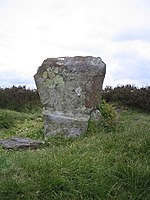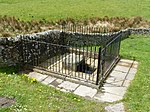Bretton Brook
Derbyshire geography stubsEngland river stubsHigh Peak, DerbyshireRivers and valleys of the Peak DistrictRivers of Derbyshire ... and 2 more
Tourist attractions in DerbyshireUse British English from June 2023

Bretton Brook is a stream flowing through Bretton in the Derbyshire Peak District. The stream is a tributary of the Highlow Brook, which is a direct tributary the River Derwent south of Hathersage.
Excerpt from the Wikipedia article Bretton Brook (License: CC BY-SA 3.0, Authors, Images).Bretton Brook
Sir William Hill Road, Derbyshire Dales
Geographical coordinates (GPS) Address Nearby Places Show on map
Geographical coordinates (GPS)
| Latitude | Longitude |
|---|---|
| N 53.314166666667 ° | E -1.6666666666667 ° |
Address
Sir William Hill Road
S32 5QT Derbyshire Dales
England, United Kingdom
Open on Google Maps











